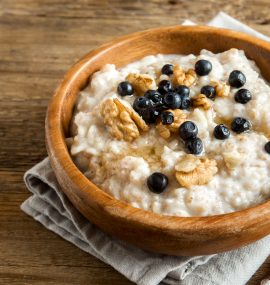Eat Better
Avoid type 2 diabetes
Keeping your blood sugar under control helps prevent type 2 diabetes and its many complications, including blindness, amputations, and kidney failure. Research suggests two effective ways to manage your blood sugar: Eat Better and Keep Moving.
The keys to Eat Better include ramping up dietary fiber and limiting your consumption of added sugars and refined grains. Your body readily digests sugar and refined gains and quickly turns them into glucose (blood sugar). Fiber slows the digestive process and reduces the spikes in blood sugar that occur after meals, especially when you eat sugary and starchy foods. Where do you get fiber? From fruits, vegetables, beans, and whole grains.
Fruits with lots of fiber include pears, apples, and avocados. Eat the whole fruit (minus the rind, core, seeds) instead of fruit juice. The whole fruit contains fiber that’s often absent in the juice. The whole fruit takes longer to chew and digest, thereby reducing the subsequent blood-sugar spike. Vegetables with abundant fiber include winter squash, collard greens, green peas, broccoli, carrots, and spinach. Beans, such as limas, black beans, lentils, and pintos, are great sources of fiber.
Whole grains provide lots of indigestible fiber. Studies show that a fiber-rich diet predicts reduced risk of type 2 diabetes and other chronic diseases. Whole grains are literally whole intact grains that haven’t been milled into flour. They include brown ice, quinoa, buckwheat, barley, and millet. Old-fashioned rolled oats and cracked wheat come close to being whole grains. The nutritional value of whole grains arises in large part from the fiber, vitamins, minerals, and phytochemicals they contain. Because we digest whole grains slower than refined grains, whole grains have lower glycemic index values. Eating foods with lower glycemic index values leads to lower after-meal blood-sugar spikes compared to eating refined carbohydrates and sugar.
Physical activity helps you manage your blood sugar, because moving around signals your muscles to allow glucose to enter muscle cells. Inside those cells, glucose breaks down and provides energy for movement and other bodily processes. Research showed that a short, brisk walk a half hour after each meal provided an extra measure of blood sugar management. Ten inactive, nonsmoking older (over 60 years old), otherwise healthy men and women but at risk for impaired glucose tolerance participated in an experiment. Each participant went through all of three exercise protocols of brisk walking: 1) 15 minutes at 30 minutes following breakfast, lunch, and dinner, 2) 45 minutes of exercise at 10:30 am, and 3) 45 minutes of exercise at 4:30 pm. Researchers found that protocol 1—walking thrice daily for 15 minutes each—was equally effective as one 45-minute exercise period in managing blood sugar over 24 hours. Post-meal exercise significantly controlled blood glucose over the ensuing three hours, while the other exercise protocols did not. Three short bouts of exercise may be easier for older or busy people than one long period. This approach to Keep Moving might increase the probability of walking for 15 minutes after each meal. The three, 15-minute post-meal, brisk walks would also achieve the widely recommended daily goal of 10,000 daily steps.
But what if your schedule prevents you from taking three after-meal walks? An after dinner walk may have the greatest relative benefit for overall daily glucose control. Especially if you would otherwise plop down in front of the TV.








